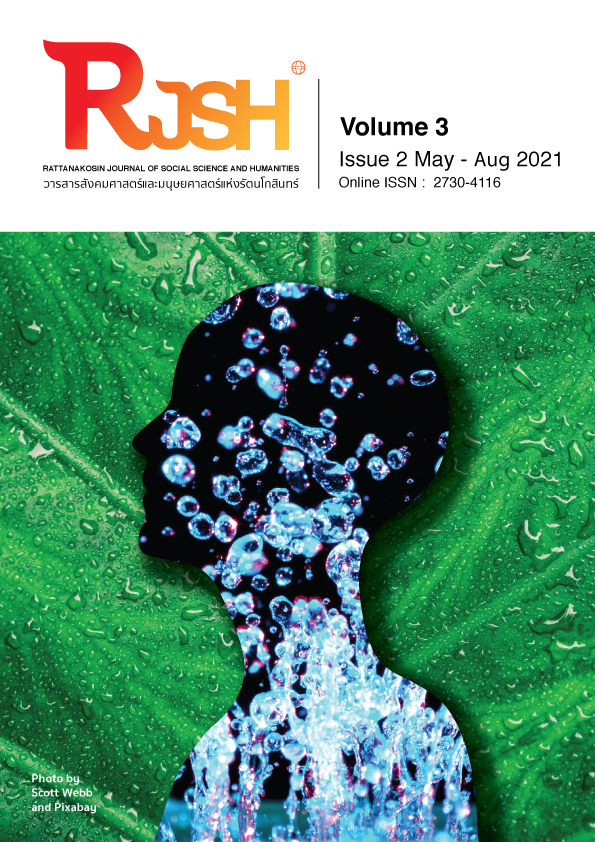English Speaking Ability of Students at Rajamangala University of Technology Lanna Lampang through Using Communicating Language Activities
Main Article Content
Abstract
The purpose of the study is to investigate students’ English speaking ability through using communicating language activities and the survey of students’ behaviors in speaking English through using communicating language activities. The sample selected by using purposive sampling is 20 students enrolling in Fundamental English 1 (01-320-103) in the second semester of the academic year 2020 at Rajamangala University of Technology Lanna Lampang. The instruments used in this study are lesson plans, English speaking ability tests and a survey of students’ behaviors in speaking English. The data are analyzed by using the T-test and mean.
The findings revealed that after the students were taught through using communicating language activities. The students’ English speaking ability was higher at the 0.05 level which was based on the hypothesis 1 which was the development of English speaking ability of students through using communicating language activities. The post-test score, in either case, was higher than that of the pre-test. The results of the survey of students’ behaviors in speaking English were increasing in every level which was 4.54 at the highest level in the fifth level which was based on the hypothesis 2 which was increasing in the development of English speaking ability.
Article Details
The content within the published articles, including images and tables, is copyrighted by Rajamangala University of Technology Rattanakosin. Any use of the article's content, text, ideas, images, or tables for commercial purposes in various formats requires permission from the journal's editorial board.
Rajamangala University of Technology Rattanakosin permits the use and dissemination of article files under the condition that proper attribution to the journal is provided and the content is not used for commercial purposes.
The opinions and views expressed in the articles are solely those of the respective authors and are not associated with Rajamangala University of Technology Rattanakosin or other faculty members in the university. The authors bear full responsibility for the content of their articles, including any errors, and are responsible for the content and editorial review. The editorial board is not responsible for the content or views expressed in the articles.
References
กระทรวงศึกษาธิการ. (2551). หลักสูตรแกนกลางการศึกษาขั้นพื้นฐาน พุทธศักราช 2551. กรุงเทพฯ: โรงพิมพ์ชุมนุมสหกรณ์การเกษตรแห่งประเทศไทย.
ข่าวสด. (2558). ภาษาอังกฤษ. ข่าวสด, 2. 24 กันยายน 2558.
เฉลิม ทองนวล. (2557). เทคนิคการสอนภาษาอังกฤษเพื่อการสื่อสาร. กรุงเทพฯ: ไฮเอ็ดพับลิชชิ่ง.
ชุลีพร เพียรช่าง. (2544). การศึกษาผลการอบรมครูเรื่องการสอนทักษะการพูดโดยใช้กิจกรรมภาษาเพื่อการสื่อสารของครูภาษาอังกฤษโรงเรียนเซ็นต์โยเซฟคอนแวนต์. สารนิพนธ์ศิลปะศาสตร มหาบัณฑิต, มหาวิทยาลัยศรีนครินทรวิโรฒ.
ณรงค์ขุ้มทอง. (2558, 24 กันยายน). ผู้เรียนและสังคมได้อะไรจากนโยบาย “ลดเวลาเรียนเพิ่มการเรียนรู้”. มติชนรายวัน, 21.
บุษบา สุวรรณโสภณ. (2539). การลดความวิตกกังวลของผู้เรียนทักษะการพูดภาษาภาษาอังกฤษโดยใช้กิจกรรมที่เน้นจิตพิสัย. วิทยานิพนธ์ศึกษาศาสตรบัณฑิต, มหาวิทยาลัยเชียงใหม่.
ประนอม สุรัสวดี.(2545). กลุ่มสาระการเรียนรู้ภาษาต่างประเทศ ภาษาอังกฤษระดับประถมศึกษา.กรุงเทพฯ: ไทยวัฒนาพานิช.
ประสิทธิ์ กัลปพฤกษ์. (2542). การพัฒนาทักษะการพูดภาษาอังกฤษของนักเรียนโดยการใช้กิจกรรมคู่. การศึกษาค้นคว้าอิสระปริญญาการศึกษามหาบัณฑิต, มหาวิทยาลัยมหาสารคาม.
พิกุล ปิ่นแก้ว. (2539). ทัศนะเชิงปฏิสัมพันธ์และผลสัมฤทธิ์ทางการเรียนของนักเรียนที่เรียนโดยวิธีการเรียนรู้แบบสหการในชั้นเรียนวิชาภาษาอังกฤษระดับมัธยมศึกษาตอนปลาย. วิทยานิพนธ์ศึกษาศาสตรมหาบัณฑิต, มหาวิทยาลัยเชียงใหม่.
ศศิลักษณ์ เกตุจรุง. (2543). การใช้กิจกรรมเพื่อการสื่อสารพัฒนาความสามารถในการพูดภาษาอังกฤษของนักเรียนชั้นมัธยมศึกษาปีที่ 2 โรงเรียนบ่อทองวงษ์จันทร์วิทยาจังหวัดชลบุรี. สารนิพนธ์ศิลปศาสตรมหาบัณฑิต, มหาวิทยาลัยศรีนครินทรวิโรฒ.
สมบัติ สิริคงคาสกุล. (2539). ผลของการสอนกลวิธีในการสื่อสารที่มีต่อความสามารถในการพูดภาษาอังกฤษเพื่อการสื่อสารของนักเรียนชั้นมัธยมศึกษาปีที่ 3. จุฬาลงกรณ์มหาวิทยาลัย.
สมิตรา อังวัฒนกุล. (2540). แนวคิดและเทคนิควิธีการสอนภาษาอังกฤษระดับมัธยมศึกษา. พิมพ์ครั้งที่ 3, กรุงเทพมหานคร.
แสงระวี ดอนแก้วบัว. (2558). ภาษาศาสตร์สำหรับครูสอนภาษาอังกฤษ. กรุงเทพฯ: จุฬาลงกรณ์มหาวิทยาลัย.
Carroll, C. (1980). Towards task-based language learning. In C. Cardin and D. Murphy (eds) Englewood Cliffs NJ: Prentice Hall.
Escola, Y.H. (1980). Certain Effects of Selected Activities of Communicative Competence Training on the Development of German: A Case Study. Dissertation Abstracts International.
Grant, N. (1988). Making the Most of Your Textbook. London: Longman.
Harmer, J. (1982). What is communicative?. ELT journal, 36(3), 164-168.
Harris, B. (1988). Key words: A history of debriefing in social psychology. In J. G. Morawski (Ed.), The rise of experimentation in American psychology (pp. 188–212). Yale University Press.
Johnson, K. (1982). Communicative Syllabus Design and Methodology. Oxford: Pergamon Press.
Juhana, J. (2012). Psychological factors that hinder students from speaking in english class. Journal of education and practice, 3(12), 91-99.
Krashen, S.D. (1984). Principle and practice in second language acquisition. Oxford: Pergamun Press.
Krashen, S.D., & Terrell, T.D. (1983). The natural approach: Language acquisition in the classroom. Hayward, CA: Alemany Press.
Littlewood, W. (1981). Drama Techniques in Language Learning. Cambridge University Press.
Morrow, K. (1981). Principles of Communication Methodology in Communication in the Classroom. Longman: Longman Group.
Nunan, D. (1991). Communicative tasks and the language curriculum. TESOL quarterly, 25(2), 279-295.
Paulston. C.B., & Selekman, H.R. (1978). “Interaction Activities in the Foreign Classroom, or How to Grow a Tulip-Rose,” in Developing Communication Skills.
Savignon, S.J. (1983). Communicative competence: Theory and classroom practice. New York: McGraw Hill.
Shumin, K. (1997). Factors to Consider: Developing Adult EFL Students' Speaking Abilities. English Teaching Forum, 35(3), 8.
Taylor, J.L., & Walford, R. (1972). Simulation in the classroom. Harmondsworth. Penguin Books.
Wilkins, D.K. (1974). Language as communication. New York: McGraw Hill.


